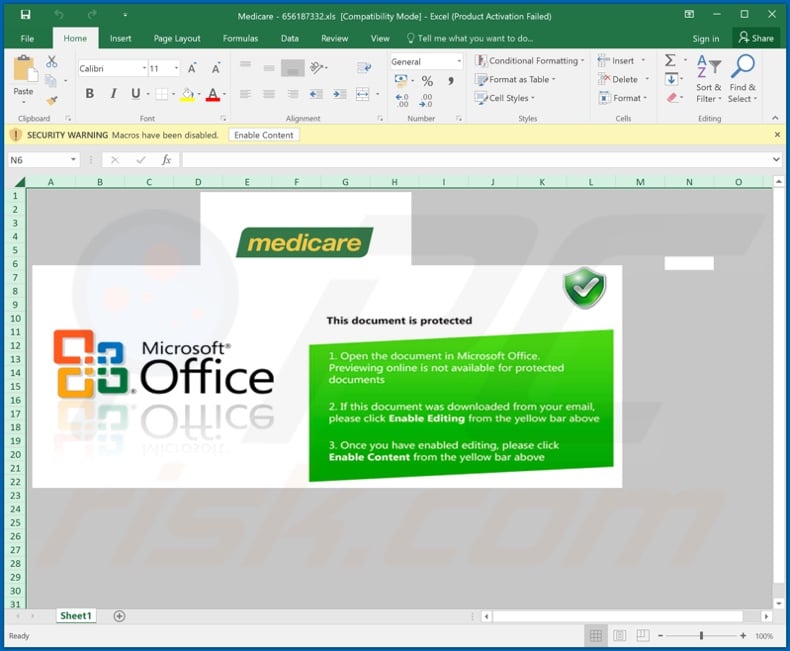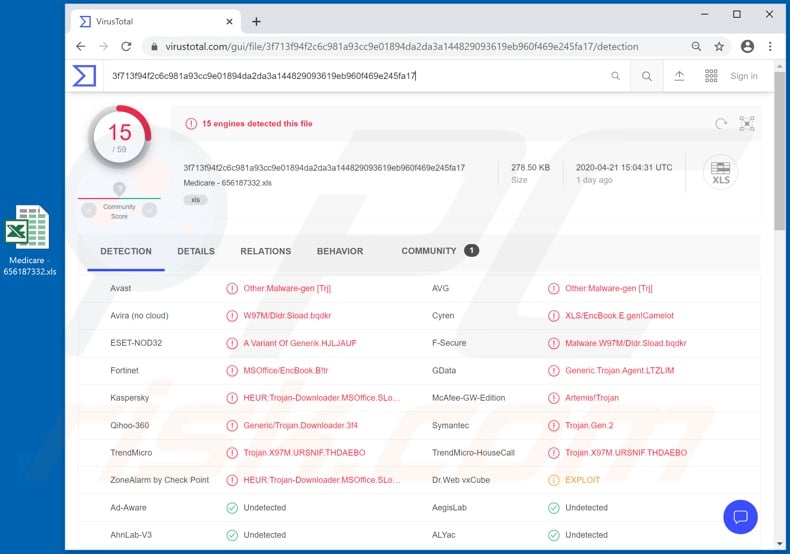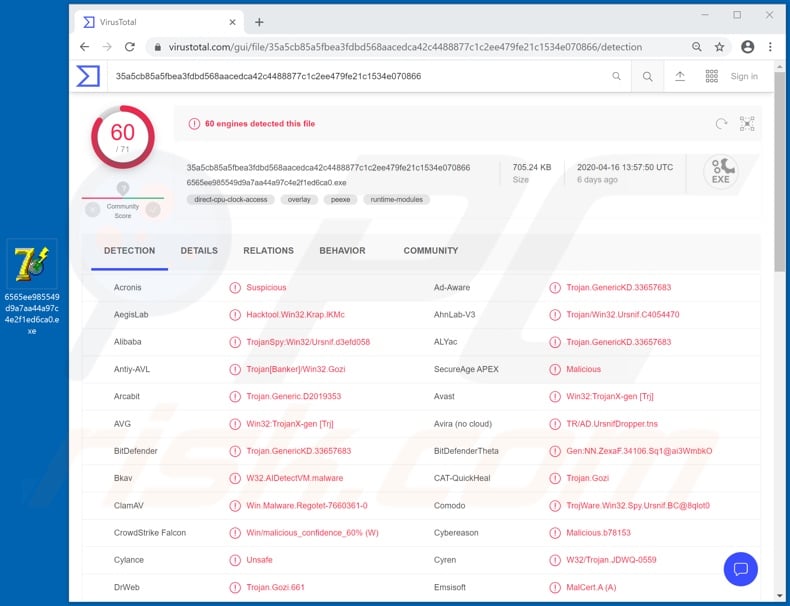Get free scan and check if your device is infected.
Remove it nowTo use full-featured product, you have to purchase a license for Combo Cleaner. Seven days free trial available. Combo Cleaner is owned and operated by RCS LT, the parent company of PCRisk.com.
What is the "Medicare" email?
The "Medicare" emails are part of a scam campaign designed to proliferate Ursnif malware. These deceptive emails claim to contain information regarding payment transactions to the Australian healthcare insurance provider, Medicare. Rather than providing the alleged information, however, the attached file contains malware.
If opened, the file can trick people into starting the Ursnif installation process.

The "Medicare" emails have several variants. In general, they claim to contain information relating to payments to and from Australian health insurance company. The subjects/titles of these messages consist of the word "Transaction", "Invoice" or "Statement" followed by a fake transaction number.
For example, "RE: Transaction 1214860391", "RE: Invoice 187790985" or "RE: Statement 21833187". The emails have malicious files attached to them, specifically Microsoft Excel spreadsheets (.xls). These infectious documents have varied files names.
Some observed samples include (but are not necessarily limited to) "Medicare - 1214860391.xls", "Medicare - 187790985.xls", "Medicare - 21833187.xls", "Medicare - 577725932-577725932.xls" and "Medicare - 656187332.xls". When opened, these files ask users to enable macro commands (e.g. to enable editing/content).
If this is done, a malicious website is opened and a dangerous executable file is downloaded from the site. This malicious file contains Ursnif malware. Ursnif is classified as spyware, due to its capability to exfiltrate and record various sensitive information.
It can collect and steal system and personal information, monitor browsing activity, retrieve stored log-ins and passwords, record key strokes (keylogging), and so on. In summary, Ursnif can compromise device integrity, lead to financial loss, serious privacy issues and identity theft.
Therefore, the "Medicare" scam emails must not be trusted, since they are bogus and are in no way associated with the genuine Medicare health insurance provider. If it is known or suspected that Ursnif (or other malware) has already infiltrated the system, you are strongly advised to use anti-virus/anti-spyware software to remove it immediately.
| Name | Medicare spam |
| Threat Type | Trojan, password-stealing virus, banking malware, spyware. |
| Hoax | Email is disguised as payment transaction information from Medicare (Australia). |
| Attachment(s) | Medicare - 1214860391.xls; Medicare - 187790985.xls; Medicare - 21833187.xls; Medicare - 577725932-577725932.xls; Medicare - 656187332.xls |
| Detection Names (Medicare - 656187332.xls attachment) | Avast (Other:Malware-gen [Trj]), Fortinet (MSOffice/EncBook.B!tr), ESET-NOD32 (A Variant Of Generik.HJLJAUF), Kaspersky (HEUR:Trojan-Downloader.MSOffice.SLoad.gen), Full List Of Detections (VirusTotal). |
| Detection Names (malicious executable) | Avast (Win32:TrojanX-gen [Trj]), BitDefender (Trojan.GenericKD.33657683), ESET-NOD32 (Win32/Spy.Ursnif.CZ), Kaspersky (HEUR:Trojan-Banker.Win32.Gozi.pef), Full List Of Detections (VirusTotal). |
| Symptoms | Trojans are designed to stealthily infiltrate the victim's computer and remain silent, and thus no particular symptoms are clearly visible on an infected machine. |
| Payload | Ursnif |
| Distribution methods | Infected email attachments, malicious online advertisements, social engineering, software 'cracks'. |
| Damage | Stolen passwords and banking information, identity theft, the victim's computer added to a botnet. |
| Malware Removal (Windows) |
To eliminate possible malware infections, scan your computer with legitimate antivirus software. Our security researchers recommend using Combo Cleaner. Download Combo CleanerTo use full-featured product, you have to purchase a license for Combo Cleaner. 7 days free trial available. Combo Cleaner is owned and operated by RCS LT, the parent company of PCRisk.com. |
Scam emails are distributed using spam campaigns. The term "spam campaign" describes a large scale operation during which deceptive emails are sent by the thousand. These messages are usually presented as "official", "important", "urgent" and similar.
As with "Medicare" emails, they can be disguised as mail from various organizations, institutions, companies, businesses, service providers, and so on.
Due to the Coronavirus/COVID-19 pandemic, there has been an increase in medical and financial aid-themed spam campaigns (e.g. "COVID-19 Relief", "Delayed payment confirmation caused by COVID-19", "COVID-19 Part Time Employment", etc.). Malware proliferation is just one purpose of such messages, and phishing attempts are likewise popular.
The latter encourage users into revealing their personal information (e.g. names, addresses, telephone numbers, emails, banking account or credit card details, etc.). They can even ask people to make various fraudulent payments. Regardless of what these scam emails claim, their purpose is identical: to generate revenue for the scammers/cyber criminals behind them.
How did "Medicare Email Virus" infect my computer?
Systems are infected via dangerous files, which are attached to deceptive/scam emails. Alternatively, the messages can contain links to malicious websites or download links of infectious files. These files can be in various formats such as: Microsoft Office (.xls, .docx, .doc, etc.) and PDF documents, archives (ZIP, RAR, etc.), executables (.exe, .run, etc.), JavaScript and others.
When malicious files are executed, run or otherwise opened, the infection process starts (i.e., malware download/installation). For example, MS Office documents cause infections by executing malicious commands.
This process begins when the file is opened in Microsoft Office programs released prior to 2010, however, in newer versions, users are asked to enable macros (i.e., enable editing/content). Therefore, in the newer versions, malware download/installation is started only after macro commands are manually enabled.
How to avoid installation of malware
You are strongly advised against opening suspicious or irrelevant emails, especially those with any attachments or links present, as this can lead to high-risk infection. Additionally, use Microsoft Office versions released after 2010.
Other common malware proliferation methods include untrusted download channels (e.g. unofficial and free file-hosting websites, Peer-to-Peer sharing networks and other third party downloaders), illegal activation ("cracking") tools and fake updaters.
Therefore, to avoid inadvertently allowing malicious content onto systems, it is important to use only official and verified download sources and to activate and update programs with functions/tools provided by legitimate developers. To ensure device integrity and user safety, it is paramount to have a reputable anti-virus/anti-spyware suite installed.
Furthermore, this software must be kept updated, and used to perform regular system scans and for the removal of detected threats and issues. If you have already opened "Medicare Email Virus" attachment, we recommend running a scan with Combo Cleaner Antivirus for Windows to automatically eliminate infiltrated malware.
Screenshot of VirusTotal detection list of the malicious attachment ("Medicare - 656187332.xls"):

Screenshot of VirusTotal detection list of the malicious executable downloaded by the attachment:

Instant automatic malware removal:
Manual threat removal might be a lengthy and complicated process that requires advanced IT skills. Combo Cleaner is a professional automatic malware removal tool that is recommended to get rid of malware. Download it by clicking the button below:
DOWNLOAD Combo CleanerBy downloading any software listed on this website you agree to our Privacy Policy and Terms of Use. To use full-featured product, you have to purchase a license for Combo Cleaner. 7 days free trial available. Combo Cleaner is owned and operated by RCS LT, the parent company of PCRisk.com.
Quick menu:
- What is Medicare spam?
- Types of malicious emails.
- How to spot a malicious email?
- What to do if you fell for an email scam?
Types of malicious emails:
![]() Phishing Emails
Phishing Emails
Most commonly, cybercriminals use deceptive emails to trick Internet users into giving away their sensitive private information, for example, login information for various online services, email accounts, or online banking information.
Such attacks are called phishing. In a phishing attack, cybercriminals usually send an email message with some popular service logo (for example, Microsoft, DHL, Amazon, Netflix), create urgency (wrong shipping address, expired password, etc.), and place a link which they hope their potential victims will click on.
After clicking the link presented in such email message, victims are redirected to a fake website that looks identical or extremely similar to the original one. Victims are then asked to enter their password, credit card details, or some other information that gets stolen by cybercriminals.
![]() Emails with Malicious Attachments
Emails with Malicious Attachments
Another popular attack vector is email spam with malicious attachments that infect users' computers with malware. Malicious attachments usually carry trojans that are capable of stealing passwords, banking information, and other sensitive information.
In such attacks, cybercriminals' main goal is to trick their potential victims into opening an infected email attachment. To achieve this goal, email messages usually talk about recently received invoices, faxes, or voice messages.
If a potential victim falls for the lure and opens the attachment, their computers get infected, and cybercriminals can collect a lot of sensitive information.
While it's a more complicated method to steal personal information (spam filters and antivirus programs usually detect such attempts), if successful, cybercriminals can get a much wider array of data and can collect information for a long period of time.
![]() Sextortion Emails
Sextortion Emails
This is a type of phishing. In this case, users receive an email claiming that a cybercriminal could access the webcam of the potential victim and has a video recording of one's masturbation.
To get rid of the video, victims are asked to pay a ransom (usually using Bitcoin or another cryptocurrency). Nevertheless, all of these claims are false - users who receive such emails should ignore and delete them.
How to spot a malicious email?
While cyber criminals try to make their lure emails look trustworthy, here are some things that you should look for when trying to spot a phishing email:
- Check the sender's ("from") email address: Hover your mouse over the "from" address and check if it's legitimate. For example, if you received an email from Microsoft, be sure to check if the email address is @microsoft.com and not something suspicious like @m1crosoft.com, @microsfot.com, @account-security-noreply.com, etc.
- Check for generic greetings: If the greeting in the email is "Dear user", "Dear @youremail.com", "Dear valued customer", this should raise suspiciousness. Most commonly, companies call you by your name. Lack of this information could signal a phishing attempt.
- Check the links in the email: Hover your mouse over the link presented in the email, if the link that appears seems suspicious, don't click it. For example, if you received an email from Microsoft and the link in the email shows that it will go to firebasestorage.googleapis.com/v0... you shouldn't trust it. It's best not to click any links in the emails but to visit the company website that sent you the email in the first place.
- Don't blindly trust email attachments: Most commonly, legitimate companies will ask you to log in to their website and to view any documents there; if you received an email with an attachment, it's a good idea to scan it with an antivirus application. Infected email attachments are a common attack vector used by cybercriminals.
To minimise the risk of opening phishing and malicious emails we recommend using Combo Cleaner Antivirus for Windows.
Example of a spam email:

What to do if you fell for an email scam?
- If you clicked on a link in a phishing email and entered your password - be sure to change your password as soon as possible. Usually, cybercriminals collect stolen credentials and then sell them to other groups that use them for malicious purposes. If you change your password in a timely manner, there's a chance that criminals won't have enough time to do any damage.
- If you entered your credit card information - contact your bank as soon as possible and explain the situation. There's a good chance that you will need to cancel your compromised credit card and get a new one.
- If you see any signs of identity theft - you should immediately contact the Federal Trade Commission. This institution will collect information about your situation and create a personal recovery plan.
- If you opened a malicious attachment - your computer is probably infected, you should scan it with a reputable antivirus application. For this purpose, we recommend using Combo Cleaner Antivirus for Windows.
- Help other Internet users - report phishing emails to Anti-Phishing Working Group, FBI’s Internet Crime Complaint Center, National Fraud Information Center and U.S. Department of Justice.
Share:

Tomas Meskauskas
Expert security researcher, professional malware analyst
I am passionate about computer security and technology. I have an experience of over 10 years working in various companies related to computer technical issue solving and Internet security. I have been working as an author and editor for pcrisk.com since 2010. Follow me on Twitter and LinkedIn to stay informed about the latest online security threats.
PCrisk security portal is brought by a company RCS LT.
Joined forces of security researchers help educate computer users about the latest online security threats. More information about the company RCS LT.
Our malware removal guides are free. However, if you want to support us you can send us a donation.
DonatePCrisk security portal is brought by a company RCS LT.
Joined forces of security researchers help educate computer users about the latest online security threats. More information about the company RCS LT.
Our malware removal guides are free. However, if you want to support us you can send us a donation.
Donate
▼ Show Discussion